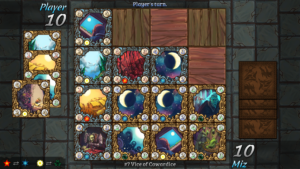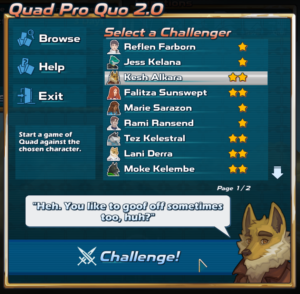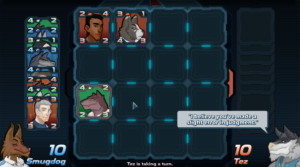Today’s Music Choice: “Quad Pro Quo 2.0”
Naturally. This is a breezy, jazzy remix of the original theme from The Tenth Line. I love it lots.
Progress Report
I spent the whole week incorporating QPQ into the main game. This wasn’t a snap decision, but one I had been putting off until I finished my last milestone. Originally, I thought it would be a simple drag-and-drop affair from my last project into this one. However, I decided I needed to rebuild the entire front-end interface (challenging opponents, browsing your collection, and setting up your play deck) to cleanly incorporate all the changes I wanted to make, so I spent the whole week doing that. The result is a more streamlined engagement system that also has more “character.” I’ll show what I mean below.
I still need to finish up the actual game before I call it “done.” This includes: building decks for each opponent, adding mouse controls to the main game, implementing new animations and effects, and writing all the challenger dialog. I hope that doesn’t take me all of next week to finish, but, we shall see.
Introducing: Quad Pro Quo 2.0
“It Rhymes!”
 The original Quad Pro Quo was, admittedly, a sudden addition to The Tenth Line. A flash of inspiration. A bit of the ol’ feature creep, if you will. But, it seemed appropriate at the same time. Superfluous card games were all the rage in RPGs from around 1999 through 2002 or so, which was the era I was aiming for, so it felt like a natural addition. I wrote a quick design (the influences are obvious, but with a tweest) and had a working prototype in about 2 days.
The original Quad Pro Quo was, admittedly, a sudden addition to The Tenth Line. A flash of inspiration. A bit of the ol’ feature creep, if you will. But, it seemed appropriate at the same time. Superfluous card games were all the rage in RPGs from around 1999 through 2002 or so, which was the era I was aiming for, so it felt like a natural addition. I wrote a quick design (the influences are obvious, but with a tweest) and had a working prototype in about 2 days.
In case you haven’t played it before, here is a quick rundown: You and your opponent have a deck of ten cards, and play on a board of 16 squares. You each take turns placing one card at a time on an empty square. If your card is placed next to an opponent’s, they’ll do battle. If your numbers are both higher than the opponent’s numbers on the touching side, you’ll capture their card. If both numbers are lower, though, you lose the card immediately. If there is a draw, no change occurs. Whoever controls the most cards when the board is filled is the winner.
Anyway, I eventually polished things up and re-wrote the AI to use the Monte Carlo method on the recommendation of a fellow designer (my original method was a sort of “weighted” measure where the AI would try every possible card in every possible spot and then pick the one with the highest weight), and then I scattered players across the game world. The idea was to give each NPC player a sort of personality expressed through their cards by giving them a “theme” – a player may prefer land cards, or prefer fire-elemental cards, so an observant player could stack their own deck for an advantage at times.
I’ll admit the “betting” system I included was a little silly and superfluous, originally designed to give a little gravity to each match. Fortunately, matches in Quad Pro Quo 2.0 won’t cost anything or run any risk. It’s purely a side diversion from the main game, and can be entirely ignored to no ill effect.
Here’s the deal: instead of looking for NPCs in the world, you’ll now play matches against your recruited allies. You can play a game of cards any time from the main “overworld” interface, and you can play against any ally whom you have recruited. Each challenger has their own difficulty rating that dictates the strength of their AI and their deck of cards, and will generally have a theming to their chosen cards as well. Each ally also carried a card of themselves, which you can win and add to your collection by defeating them in a match. Beaten allies won’t give up more rewards, but they can be battled again and will play with a higher level deck if you want a challenge. Cards can also be earned through the main game by unlocking new classes – spending Mastery in a class will unlock a mid-level “class” card that can help bolster your collection.
 The challenger selection interface is on the right. Since you’ll be playing against the main characters, I decided to inject some personality here and there. On the selection screen, each character will have a “challenge” quote for you, with a separate one for when they’ve been beaten before. I like little touches like that. This extends into the “real” game, too, where your opponent will spout off or shout things depending on how well (or poorly) they’re performing.
The challenger selection interface is on the right. Since you’ll be playing against the main characters, I decided to inject some personality here and there. On the selection screen, each character will have a “challenge” quote for you, with a separate one for when they’ve been beaten before. I like little touches like that. This extends into the “real” game, too, where your opponent will spout off or shout things depending on how well (or poorly) they’re performing.
So, what has changed in the main game? A little bit, but not a ton. The biggest change is in the elemental system: instead of four elements (fire opposing ice, and sky opposing nox), I’ve changed it into a sort of “weapon triangle” that otherwise works in the same manner. Sun (red) cards beat stars (green), stars beat moon (blue), and moon beats sun. “Beating” an opposing element means your numbers gain +1.5 against the opponent when attacking or defending. Why 1.5? Well, it helps overpower a card that is only 1 point stronger, but not enough to tie a vastly stronger number (2 or more).
I’ve also been a bit more cognizant about how the numbers should be arranged, and I have tightened up their spread considerably. For instance, in the original game, any card with large numbers diagonally across from each other was potentially unbeatable – an oversight on my part. So, I’m designing cards in “tiers” now, where all four numbers add up to a certain sum. But, if the card has a strong diagonal factor, I make the total sum slightly lower to compensate. We’ll see how that works out.
 A work-in-progress of the board is there on the left. This is by no means finished, or polished. Everything is appropriately sci-fi-y now, with cards being represented by glowing screens and lights dotting the game field. Your opponent will shout things using word balloons, that disappear relatively quickly, but if you want to get rid of them entirely, I’ll be adding a “mute” checkbox to hide their emotional outbursts for the rest of the match. I am thinking about rearranging the deck along the side since it will be mouse controlled. That’s stuff I’ll address in the next week.
A work-in-progress of the board is there on the left. This is by no means finished, or polished. Everything is appropriately sci-fi-y now, with cards being represented by glowing screens and lights dotting the game field. Your opponent will shout things using word balloons, that disappear relatively quickly, but if you want to get rid of them entirely, I’ll be adding a “mute” checkbox to hide their emotional outbursts for the rest of the match. I am thinking about rearranging the deck along the side since it will be mouse controlled. That’s stuff I’ll address in the next week.
I also plan to add a little “hint” overlay when you mouse over a blank spot after choosing a card. Basically, it will give a little arrow indicator on each corner of whether the card would win or lose a battle against its neighbor, so you can quickly gauge a good or poor move.
This week, I’m hoping to finish all the little missing pieces and polish to call the card game more or less “done.” Like with the original game, it’s just a fun little side diversion from all the drama and tactical battles, with no real stakes except maybe an achievement or two.





